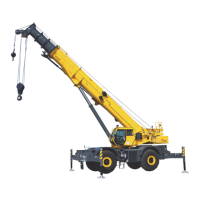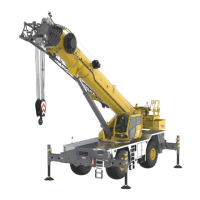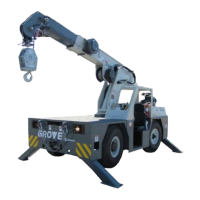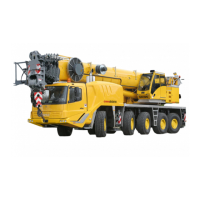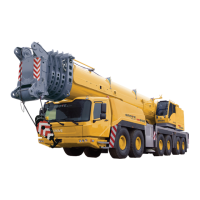2-25
GRT9165 SERVICE MANUAL HYDRAULIC SYSTEM
Published 10-01-2020 Control # 699-00
Carrier Manifold Valve
The carrier manifold valve (Figure 2-8) is located on the
inside carrier frame rail at the turntable bearing (Figure 2-6).
This manifold controls the following functions:
• Load Sense Dump
• Rear Steer
• Axle Lockout
• Outriggers (Extend/Retract)
• Transmission Fan Motor
• Park Brake
• Suspension Fill
Supply oil to all functions on the carrier combination manifold
valve is limited by a pressure reducing valve.
Load Sense Dump
The LS dump function consists of a shuttle valve and a
control valve which combines the load sense oil received
from the carrier and superstructure circuits and diverts it to
tank during engine cranking. This action aids in starting the
engine by preventing the pumps from building pressure
during the engine cranking function, thereby lessening the
load on the engine starter.
Rear Steer
The rear steer function is controlled by a control valve with
dual cross-port, pilot-operated check valves in the work
lines. The dual cross-port, pilot-operated check valves
maintain pressure on the rod and piston of both rear steer
cylinders when stationary and when turning.
Outriggers
The outrigger extend/retract circuit consists of a solenoid-
controlled valve, which is controlled by the control system
based on operator inputs. A request to extend or retract an
outrigger jack or extension results in the crane control
system energizing the respective solenoid, thereby sending
system pressure to shift a dual pilot-controlled valve, which
controls the flow of oil to extend and retract the four jack
cylinders and four extension cylinders. A check valve
maintains a maximum pressure of 100 psi in the retract
circuit.
Transmission Cooler Fan
The oil cooler fan circuit consists of a proportional flow
control valve in sequence with a solenoid-operated,
proportional flow control valve, which is controlled by the
crane control system, based on inputs from the transmission
oil temperature sending unit and the hydraulic oil sending
unit. Return oil from the motor goes to tank.
Park Brake
The park brake solenoid valve controls the flow of hydraulic
oil to the parking brake. In its de-energized position, the inlet
port is blocked and the parking brake actuator is drained to
the reservoir. When the solenoid is energized, the reservoir
port is blocked and pressurized oil is directed to the parking
brake actuator.
Suspension Fill
The suspension fill solenoid valves control the flow of
hydraulic oil to the suspension cylinders. The suspension
cylinders control the height of the rear suspension. For more
information, Suspension Manifold Valve, page 2-28.
Removal
1. Tag and disconnect the electrical connectors to the
valve. Tape the lead ends.
2. Tag and disconnect the hydraulic lines to the valve
assembly. Cap or plug the lines and ports.
3. Remove the capscrews, nuts, and washers securing the
valve assembly to the frame. Remove the valve as a
complete assembly.
Installation
1. Install the valve assembly to the frame. Secure the valve
assembly with the flatwashers, lockwashers, hex nuts
and capscrews. Torque capscrews - refer to Fasteners
and Torque Values, page 1-16 for proper torque value.
2. Connect the hydraulic lines to the valve assembly as
tagged during removal.
3. Connect the electrical connectors to the valve assembly
as tagged during removal.
Functional Check
1. Cycle an outrigger cylinder several times. Verify the
cylinder extends and retracts properly.
2. Rear steer the crane to the left and to the right several
times. Verify the crane steers properly in both directions.
3. Ensure the axle lockout function operates properly by
performing the procedures under Axle Oscillation
Lockouts Operation in section 3 of the Operator Manual.
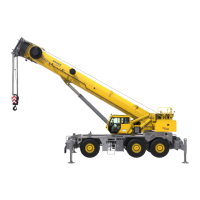
